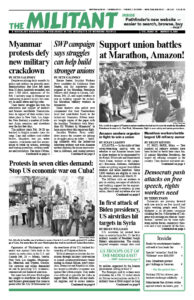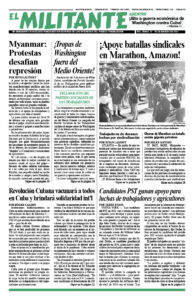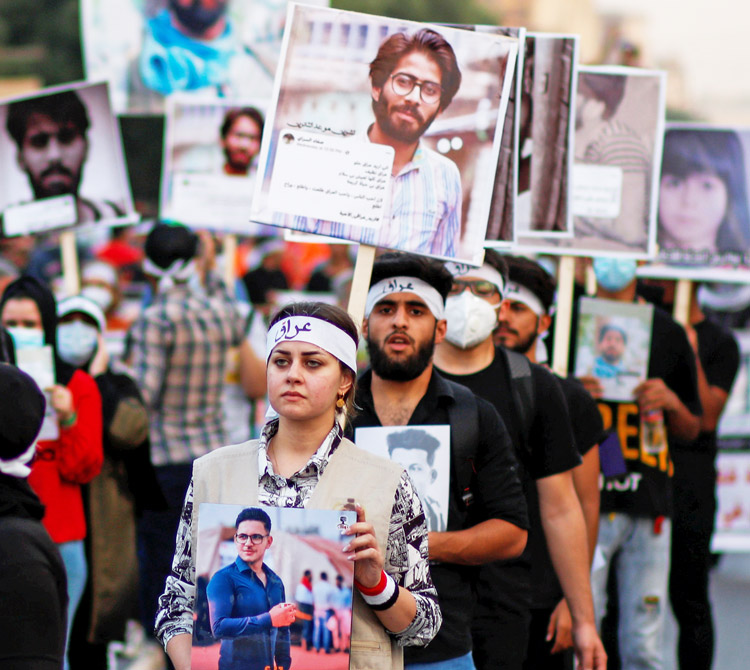U.S. airstrikes hit several locations in eastern Syria Feb. 25, the first military assaults of President Joseph Biden’s administration. The attacks targeted weapons storage sites used by militias organized by the Iranian government, killing at least 17.
The Pentagon said its actions were retaliation for a Feb. 15 rocket attack by Tehran-backed militias on the U.S. military base at Erbil airport in Iraqi Kurdistan, which killed a civilian contractor and injured several others. U.S. officials say the airstrikes were conducted in collaboration with the Iraqi regime. Iraq’s Ministry of Defense denies this.
To defend their interests in the strategic, oil-rich region the U.S. rulers deploy at least 60,000 troops at bases across the Mideast along with a massive arsenal of warplanes, missiles and other armaments.
Both Washington and Tehran are jockeying for control in Iraq. Their conflict is part of broader struggles between contending capitalist powers intervening in the region, including the rulers in Russia, Saudi Arabia and Turkey. All seek to defend their economic and strategic interests at the expense of their rivals.
The Iranian rulers have entrenched their armed forces and allied militias in Iraq and in Lebanon, Syria and Yemen. Their drive to extend their power has come at a deadly cost to working people in Iran and throughout the region. Fed up with plummeting living standards and the toll of the regime’s wars, working people joined demonstrations across Iran in November 2019.
The most recent U.S. airstrikes took place as Biden looks for a way to return to the 2015 deal imposed on the Iranian government that’s aimed at preventing it from acquiring nuclear weapons. Former President Donald Trump withdrew the U.S. from the pact in 2018. Iranian officials say they will only rejoin the accord after Washington lifts its sanctions — something the Biden administration refuses to do. The sanctions severely restrict the Iranian rulers’ trade while their impact falls hardest on workers and farmers.
Tehran has begun producing uranium enriched to 20% purity. On Feb. 23 it began restricting access of international inspectors to some of its nuclear facilities.
The White House targeted Tehran-back militias on Syrian territory instead of those in Iraq to avoid destabilizing the weak Iraqi government.
Daily protests in Iraq’s southern city of Nasiriyah, which began Feb. 22, highlight the political challenges confronting the regime in Baghdad. Demonstrators are demanding the resignation of Dhi Qar Provincial Gov. Nazem al-Waeli and the arrest and prosecution of those responsible for abducting or killing participants in rounds of anti-government protests that began in 2019.
During these actions tens of thousands of working people and youth took to the streets demanding jobs, an end to rule by sectarian political parties and a halt to military interventions and plunder of the country’s resources by Tehran and Washington. At least 600 people have since been killed by security forces.
During the recent protests in Nasiriyah, security forces fired live ammunition into crowds of demonstrators, killing 10 and wounding dozens.
But the deadly attacks did not deter protesters. “The demonstrations will not stop until our demands are fulfilled and the governor is dismissed,” Salam al Ghazi told Rudaw Feb. 25.
On Feb. 26 governor al-Waeli resigned. Prime Minister Mustafa al-Kadhimi appointed a successor and set up a committee he said would investigate the killings of demonstrators.
Actions in support of the demonstrations in Nasiriyah were held in other cities, including Baghdad and the port city of Basra. Demonstrators in Nasiriyah halted their actions Feb. 28, giving the new governor three days to respond to their demands.


